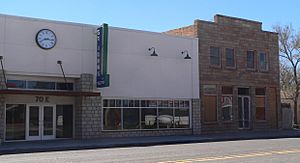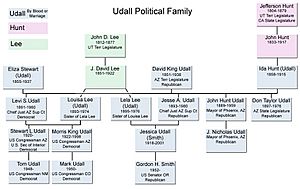St. Johns, Arizona facts for kids
Quick facts for kids
St. Johns, Arizona
|
||
|---|---|---|
|
City
|
||
| City of St. Johns | ||

Downtown St. Johns
|
||
|
||
| Motto(s):
Town of Friendly neighbors
|
||
| Country | United States | |
| State | Arizona | |
| County | Apache | |
| Area | ||
| • Total | 26.09 sq mi (67.56 km2) | |
| • Land | 25.91 sq mi (67.10 km2) | |
| • Water | 0.18 sq mi (0.46 km2) | |
| Elevation | 5,745 ft (1,751 m) | |
| Population
(2020)
|
||
| • Total | 3,417 | |
| • Density | 131.89/sq mi (50.92/km2) | |
| Time zone | UTC-7 (Arizona Time Zone) | |
| ZIP Code |
85936
|
|
| FIPS code | 04-62350 | |
| GNIS feature ID | 2411761 | |
St. Johns is a city in Apache County, Arizona, United States. It is the main city for the county. You can find it along U.S. Route 180. In 2010, about 3,480 people lived there.
Contents
History of St. Johns
The area where St. Johns is now was first called Tsézhin Deezʼáhí by the Navajo people. This name means "rock formations." Later, Spanish explorers called it El Vadito, which means "the little crossing." This was because it was a good place to cross the Little Colorado River.
In 1864, a trader named Solomon Barth started passing through the area. He was moving salt from a lake in Zuni land to Prescott, Arizona. In 1873, Barth won enough money in a poker game to buy land in St. Johns. He started a ranch with his brothers. He changed the name from El Vadito to San Juan. People are not sure if he named it after the first woman resident, Maria San Juan Baca de Padilla, or a special feast day.
Other settlers arrived, and by 1872, a farming community had grown. In 1875 or 1879, Solomon Barth sold his land to Ammon M. Tenney, a member of The Church of Jesus Christ of Latter-day Saints. A community for this church, called Salem, was set up nearby in 1880. It was later moved to higher ground.
St. Johns has been the county seat (the main city for the county government) for most of Apache County's history. Apache County was created in 1879. St. Johns became the county seat in 1879, then again in 1882, and it has stayed that way ever since.
Geography and Climate
St. Johns is in the White Mountains area of northeast Arizona. The city covers about 67.6 square kilometers (26.1 square miles). Most of this area is land, with a small part being water.
The weather in St. Johns is called humid continental. This means it has cold winters with snow. Summers are warm, and sometimes there are thunderstorms. The temperature can change a lot between day and night. For example, a warm day might be followed by a freezing night.
| Climate data for St. Johns, Arizona, 1991–2020 normals, extremes 1901–present | |||||||||||||
|---|---|---|---|---|---|---|---|---|---|---|---|---|---|
| Month | Jan | Feb | Mar | Apr | May | Jun | Jul | Aug | Sep | Oct | Nov | Dec | Year |
| Record high °F (°C) | 70 (21) |
72 (22) |
76 (24) |
80 (27) |
86 (30) |
95 (35) |
92 (33) |
91 (33) |
90 (32) |
84 (29) |
73 (23) |
69 (21) |
95 (35) |
| Mean maximum °F (°C) | 60 (16) |
61 (16) |
65 (18) |
71 (22) |
79 (26) |
86 (30) |
88 (31) |
83 (28) |
81 (27) |
76 (24) |
68 (20) |
62 (17) |
89 (32) |
| Mean daily maximum °F (°C) | 45.8 (7.7) |
47.5 (8.6) |
50.5 (10.3) |
59.1 (15.1) |
67.2 (19.6) |
76.3 (24.6) |
77.1 (25.1) |
75.0 (23.9) |
72.9 (22.7) |
65.0 (18.3) |
55.1 (12.8) |
48.5 (9.2) |
61.7 (16.5) |
| Daily mean °F (°C) | 26.2 (−3.2) |
28.1 (−2.2) |
32.3 (0.2) |
39.5 (4.2) |
45.8 (7.7) |
54.2 (12.3) |
60.1 (15.6) |
58.7 (14.8) |
53.8 (12.1) |
45.1 (7.3) |
35.4 (1.9) |
28.9 (−1.7) |
42.3 (5.8) |
| Mean daily minimum °F (°C) | 6.7 (−14.1) |
8.2 (−13.2) |
14.2 (−9.9) |
19.9 (−6.7) |
24.5 (−4.2) |
32.1 (0.1) |
43.0 (6.1) |
42.2 (5.7) |
34.6 (1.4) |
25.1 (−3.8) |
15.8 (−9.0) |
9.4 (−12.6) |
23.0 (−5.0) |
| Mean minimum °F (°C) | −17 (−27) |
−14 (−26) |
−6 (−21) |
7 (−14) |
15 (−9) |
22 (−6) |
35 (2) |
34 (1) |
25 (−4) |
15 (−9) |
−1 (−18) |
−11 (−24) |
−22 (−30) |
| Record low °F (°C) | −40 (−40) |
−33 (−36) |
−27 (−33) |
−9 (−23) |
4 (−16) |
12 (−11) |
23 (−5) |
25 (−4) |
16 (−9) |
3 (−16) |
−15 (−26) |
−30 (−34) |
−40 (−40) |
| Average precipitation inches (mm) | 2.89 (73) |
1.84 (47) |
2.34 (59) |
1.15 (29) |
0.43 (11) |
0.98 (25) |
4.92 (125) |
4.93 (125) |
2.17 (55) |
2.04 (52) |
1.47 (37) |
2.70 (69) |
27.86 (707) |
| Average snowfall inches (cm) | 24.8 (63) |
17.9 (45) |
17.4 (44) |
6.3 (16) |
1.1 (2.8) |
0.0 (0.0) |
0.0 (0.0) |
0.0 (0.0) |
0.0 (0.0) |
1.8 (4.6) |
7.4 (19) |
21.2 (54) |
97.9 (248.4) |
| Source: WRCC | |||||||||||||
Population and People
| Historical population | |||
|---|---|---|---|
| Census | Pop. | %± | |
| 1880 | 546 | — | |
| 1890 | 482 | −11.7% | |
| 1910 | 835 | — | |
| 1920 | 1,386 | 66.0% | |
| 1930 | 1,386 | 0.0% | |
| 1950 | 1,469 | — | |
| 1960 | 1,310 | −10.8% | |
| 1970 | 1,320 | 0.8% | |
| 1980 | 3,368 | 155.2% | |
| 1990 | 3,294 | −2.2% | |
| 2000 | 3,269 | −0.8% | |
| 2010 | 3,480 | 6.5% | |
| 2020 | 3,417 | −1.8% | |
| U.S. Decennial Census | |||
In 2000, there were 3,269 people living in St. Johns. Many households had children under 18. Most families were married couples living together. The average household had about three people.
The median age of people in the city was 31 years old. This means half the people were younger than 31, and half were older. About 35% of the population was under 18.
Fun Things to See and Do
St. Johns has some interesting places to visit:
- The Apache County Historical Society Museum is a great place to learn about the area's past.
- There are four places in St. Johns listed on the National Register of Historic Places. These include the Isaacson Building, the Lower Zuni River Archeological District, the Lyman Lake Rock Art Site, and the Rattlesnake Point Pueblo.
- St. Johns is close to the Placerias Quarry. This is where many fossils of an ancient animal called Placerias were found in 1930.
The city is also on a beautiful route from Phoenix to Albuquerque, New Mexico. Within an hour's drive, you can find:
- Apache-Sitgreaves National Forest
- Petrified Forest National Park
- The Painted Desert
- Lyman Lake State Park
- Several Indian reservations, like the Navajo Nation and Zuni Indian Reservation.
Yearly Celebrations
St. Johns hosts several fun events each year:
- Pioneer Days, put on by The Church of Jesus Christ of Latter-Day Saints.
- San Juan Fiesta, hosted by St. Johns Catholic Church.
- The Apache County Fair.
- A Christmas Light Parade.
Schools and Learning
St. Johns is part of the St. Johns Unified School District. Students attend Coronado Elementary School, St. Johns Middle School, and St. Johns High School. For older students, there is also the St. Johns Center of Northland Pioneer College.
The Apache County Library District has its main office and the St. Johns Public Library in the city.
Local Economy
The Salt River Project runs the Coronado Generating Station near St. Johns. This power plant helps provide electricity.
Getting Around
The BNSF Railway has a line that serves the Coronado Generating Station.
Famous People from St. Johns
- Albert Franklin Banta: A politician and newspaper editor from the early days of Arizona.
- Rachel Allen Berry: The first woman to be elected to the Arizona Legislature.
- Jack A. Brown: An Arizona state politician and rancher.
- Rex E. Lee: A lawyer who worked for the U.S. government and was president of a university.
- Eric Shumway: A former president of BYU Hawaii.
- Brady Udall: A well-known writer.
- Don Taylor Udall: A state politician and judge.
- David King Udall: A state politician and leader.
- Ida Hunt Udall: A diarist and homesteader who wrote about her life.
- Jesse Addison Udall: A chief justice (top judge) of the Arizona Supreme Court.
- Levi Stewart Udall: A lawyer and chief justice of the Arizona Supreme Court.
- Morris "Mo" Udall: A politician who once ran for President of the U.S.
- Stewart Udall: A politician who served as the U.S. Secretary of Interior.
See also
 In Spanish: St. Johns (condado de Apache) para niños
In Spanish: St. Johns (condado de Apache) para niños





